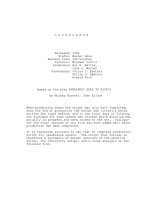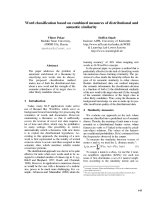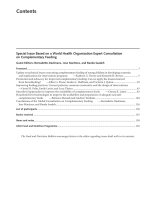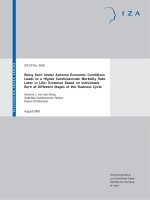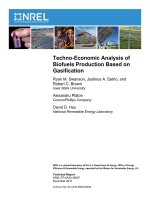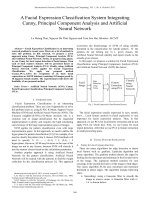facial expression classification based on
Bạn đang xem bản rút gọn của tài liệu. Xem và tải ngay bản đầy đủ của tài liệu tại đây (434.28 KB, 8 trang )
IJCSI International Journal of Computer Science Issues, Vol. 8, Issue 3, May 2011
ISSN (Online): 1694-0814
www.IJCSI.org 1
Facial Expression Classification Based on
Multi Artificial Neural Network and Two Dimensional Principal
Component Analysis
Thai Le
1
, Phat Tat
1
and Hai Tran
2
1
Computer Science Department, University of Science, Ho Chi Minh City, Vietnam
2
Informatics Technology Department, University of Pedagogy, Ho Chi Minh City, Vietnam
Abstract
Facial expression classification is a kind of image classification
and it has received much attention, in recent years. There are
many approaches to solve these problems with aiming to increase
efficient classification. One of famous suggestions is described as
first step, project image to different spaces; second step, in each
of these spaces, images are classified into responsive class and
the last step, combine the above classified results into the final
result. The advantages of this approach are to reflect fulfill and
multiform of image classified. In this paper, we use 2D-PCA and
its variants to project the pattern or image into different spaces
with different grouping strategies. Then we develop a model
which combines many Neural Networks applied for the last step.
This model evaluates the reliability of each space and gives the
final classification conclusion. Our model links many Neural
Networks together, so we call it Multi Artificial Neural Network
(MANN). We apply our proposal model for 6 basic facial
expressions on JAFFE database consisting 213 images posed by
10 Japanese female models.
Keywords: Facial Expression, Multi Artificial Neural Network
(MANN), 2D-Principal Component Analysis (2D-PCA).
1. Introduction
There are many approaches apply for image classification.
At the moment, the popular solution for this problem:
using K-NN and K-Mean with the different measures,
Support Vector Machine (SVM) and Artificial Neural
Network (ANN).
K-NN and K-Mean method is very suitable for
classification problems, which have small pattern
representation space. However, in large pattern
representation space, the calculating cost is high.
SVM method applies for pattern classification even with
large representation space. In this approach, we need to
define the hyper-plane for classification pattern [1]. For
example, if we need to classify the pattern into L classes,
SVM methods will need to specify 1+ 2+ … + (L-1) = L
(L-1) / 2 hyper-plane. Thus, the number of hyper-planes
will rate with the number of classification classes. This
leads to: the time to create the hyper-plane high in case
there are several classes (costs calculation).
Besides, in the situation the patterns do not belong to any
in the L given classes, SVM methods are not defined [2].
On the other hand, SVM will classify the pattern in a given
class based on the calculation parameters. This is a wrong
result classification.
One other approach is popular at present is to use Artificial
Neural Network for the pattern classification. Artificial
Neural Network will be trained with the patterns to find the
weight collection for the classification process [3]. This
approach overcomes the disadvantage of SVM of using
suitable threshold in the classification for outside pattern.
If the patterns do not belong any in L given classes, the
Artificial Neural Network identify and report results to the
outside given classes.
In this paper, we propose the Multi Artificial Neural
Network (MANN) model to apply for image classification.
Firstly, images are projected to difference spaces by Two
Dimensional Principal Component Analysis (2D-PCA).
Secondly, in each of these spaces, patterns are classified
into responsive class using a Neural Network called Sub
Neural Network (SNN) of MANN.
IJCSI International Journal of Computer Science Issues, Vol. 8, Issue 3, May 2011
ISSN (Online): 1694-0814
www.IJCSI.org 2
Lastly, we use MANN’s global frame (GF) consisting
some Component Neural Network (CNN) to compose the
classified result of all SNN.
Image
Feature
extraction using
2D-PCA
MANN
Fig 1. Our Proposal Approach for Image Classification
2. Background and Related Work
There are a lot of approaches to classify the image featured
by m vectors X= (v
1
, v
2
, , v
m
). Each of patterns is needed
to classify in one of L classes: Ω = {Ωi | 1≤ i≤ L}. This is a
general image classification problem [3] with parameters
(m, L).
Vector V
1
{1,2, ,L}
i in
{1,2, ,L}
Vector V
2
i in
{1,2, ,L}
Vector V
m
i in
{1,2, ,L}
X
………… … ……
i in
Fig 2. Image with m feature vectors Classification
First, the extraction stage featured in the image is
performed. It could be used wavelet transform, or Principal
Component Analysis (PCA). PCA known as one of the
well-known approach for facial expression extraction,
called “Eigenface” [3]. In traditional PCA, the face images
must be converted into 1D vector which has problem with
high dimensional vector space.
Then, Yang et al. [12] has proposed an extension of PCA
technique for face recognition using gray-level images.
2D-PCA treats image as a matrix and computes directly on
the so-called image covariance matrix without image-to-
vector transformation. The eigenvector estimates more
accurate and computes the corresponding eigenvectors
more efficiently than PCA. D. Zhang et al. [13] was
proposed a method called Diagonal Principal Component
Analysis (DiaPCA), which seeks the optimal projective
vectors from diagonal face images and therefore the
correlations between variations of rows and those of
columns of images can be kept [3]. That is the reason why,
in this paper, we used 2D-PCA (rows, columns and block-
based) and DiaPCA (diagonal-based0 for extracting facial
feature to be the input of Neural Network.
Fig 3. Facial Feature Extraction
Sub-Neural Network will classify the pattern based on the
responsive feature. To compose the classified result, we
can use the selection method, average combination method
or build the reliability coefficients…
X
V
1
V
2
V
m
………
………
Fig 4. Processing of Sub Neural Networks
The selection method will choose only one of the classified
results of a SNN to be the whole system’s final conclusion:
P(Ωi | X) = Pk(Ωi | X) (k=1 m)
(1)
Where, Pk(Ωi | X) is the image X’s classified result in the
Ωi class based on a Sub Neural Network, P(Ωi | X) is the
Classification
Decision
Facial
Image
Column-based
2D-PCA
Row-based
2D-PCA
Diagonal-based
DiaPCA
Block-based
2D-PCA
Feature
vector V
1
Feature
vector V
2
Feature
vector V
3
Feature
vector V
4
IJCSI International Journal of Computer Science Issues, Vol. 8, Issue 3, May 2011
ISSN (Online): 1694-0814
www.IJCSI.org 3
pattern X’s final classified result in the Ωi. Clearly, this
method is subjectivity and omitted information.
The average combination method [4] uses the average
function for all the classified result of all SNN:
1
1
( | ) ( | )
m
i k i
k
P X P X
m
(2)
This method is not subjectivity but it set equal the
importance of all image features.
X
P
1
P
2
P
L
1/m
1/m
1/m
1/m
1/m
1/m
1/m
1/m
1/m
V
1
V
2
V
m
Fig 5. Average combination method
On the other approach is building the reliability
coefficients attached on each SNN’s output [4], [5]. We
can use fuzzy logic, SVM, Hidden Markup Model (HMM)
[6]… to build these coefficients:
1
( | ) ( | )
m
i k k i
k
P X r P X
(3)
Where, r
k
is the reliability coefficient of the k
th
Sub Neural
Network. For example, the following model uses Genetics
Algorithm to create these reliability coefficients.
X
GA
V
1
V
2
V
m
Fig 6. NN_GA model [4]
In this paper, we propose to use Neural Network technique.
In details, we use a global frame consisting of some
CNN(s). The weights of CNN(s) evaluate the importance
of SNN(s) like the reliability coefficients. Our model
combines many Neural Networks, called Multi Artificial
Neural Network (MANN).
Fig 7. PCA and MANN combination
3. Image Feature Extraction using 2D-PCA
3.1 Two Dimensional Principal Component Analysis
(2D-PCA)
Assume that the training data set consists of N face images
with size of m x n. X
1
, X
2
…, X
N
are the matrices of sample
images. The 2D-PCA proposed by Yang et al. [2] is as
follows:
Step 1. Obtain the average image
X
of all training
samples:
N
i
i
X
N
X
1
1
(4)
Step 2. Estimate the image covariance matrix
XXXX
N
C
i
T
N
i
i
1
1
(5)
Step 3. Compute d orthonormal vectors W
1
, W
2
, …,
W
d
corresponding to the d largest eigenvalues of C. W
1
,
W
2
,…, W
d
construct a d-dimensional projection subspace,
which are the d optimal projection axes.
Step 4. Project X
1
, X
2
…, X
N
on each vector W
1
,
W
2
, …, W
d
to obtain the principal component vectors:
IJCSI International Journal of Computer Science Issues, Vol. 8, Issue 3, May 2011
ISSN (Online): 1694-0814
www.IJCSI.org 4
ij
j
i
WAF
, i=1 d; j=1 N
(6)
Step 5. The reconstructed image of a sample image
Aj is defined as:
T
i
d
i
j
ijrecs
WFA
1
)(
(7)
3.2 DiaPCA
The DiaPCA extract the diagonal feature which reflects
variations between rows and columns. For each face image
in training set, the corresponding diagonal image is defined
as follows:
a b c d
e
i
f g h
j k l
Image
Row=3, column=4
a b c d
f
k
g h e
l i j
a b c d
e
i
f g h
j k l
a b c d
e
i
f g h
j k l
Right addition
Right shift
a b c d
f
k
g h e
l i j
a b c d
f
k
g h e
l i j
a b c d
e
i
f g h
j k l
Reconstructed
image
Left addition
Left shift
Diagonal image
Fig 8. Extract the diagonal feature if rows ≤ columns
a b c
d
g
j
e f
h i
k l
a b c
d
g
j
e f
h i
k l
a b c
d
g
j
e f
h i
k l
a e i
d
g
j
h l
k c
b k
a e i
d
g
j
h l
k c
b k
a e i
d
g
j
h l
k c
b k
a b c
d
g
j
e f
h i
k l
Down addition
Up addition
Down shift
Up shift
Diagonal image
Reconstructed
image
Image
Row=4, column=3
Fig 9. Extract the diagonal feature if rows > columns
3.3 Facial Feature Extraction
Facial feature extraction used 2D-PCA and its variants to
project the pattern or image into different spaces with
different grouping strategies. A facial image will be
projected to 4 presentation spaces by PCA (column-based,
row-based, diagonal-based, and block-based). Each of
above presentation spaces extracts to the feature vectors.
So a facial image will be presented by V
1
, V
2
, V
3
, V
4
. In
particular, V
1
is the feature vector of column-based image,
V
2
is the feature vector of row-based image, V
3
is the
feature vector of diagonal -based image and V
4
is the
feature vector of block -based image.
Feature vectors (V
1
, V
2
, V
3
, V
4
) presents the difference
orientation of original facial image. They are the input to
Multi Artificial Neural Network (MANN), which generates
the classified result.
Input image
Column-based
Row-based
Diagonal-based
Block-based
Feature vector
Feature vector
Feature vector
Feature vector
Fig 10. Facial Feature Extraction using 2D-PCA and DiaPCA
3. Multi Artificial Neural Network for Image
Classification
3.1 The MANN structure
Multi Artificial Neural Network (MANN), applying for
pattern or image classification with parameters (m, L), has
m Sub-Neural Network (SNN) and a global frame (GF)
consisting L Component Neural Network (CNN). In
particular, m is the number of feature vectors of image and
L is the number of classes.
Definition 1: SNN is a 3 layers (input, hidden, output)
Neural Network. The number input nodes of SNN depend
on the dimensions of feature vector. SNN has L (the
